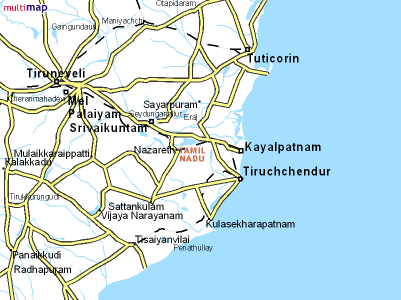இரண்டாவது குடியேற்றம்:
கி.பி;. 842ல் எகிப்து தலைநகர் கெய்ரோவில் கலீபா 'அல்வாதிக்' ஆட்சி காலத்தில் செய்யிதினா அபுபக்கர் ரலியல்லாஹு அன்ஹு அவர்கள் வம்சாவழியைச் சார்ந்த முஹம்மது கல்ஜி ரலியல்லாஹு அன்ஹு அவர்கள் தலைமையில் ஒரு குழுவினர் எகிப்தில் முஃதஜிலா கொள்கையை ஏற்க மறுத்து ஈமானை காத்திட ஹிஜ்ரத் செய்து கடல் மார்க்கமாக ஜயவீர ராஜகாரு வேந்தர் காலத்தில் காயல்பட்டணம் வந்து சேர்ந்தனர். இவர்கள் இந்நகரில் கி.பி.843ல் ஜும்ஆ பெரிய பள்ளியை கட்டினர்.
காயல்பட்டணம் காட்டு மொகுதூம் வலியுல்லாஹ் ரலியல்லாஹு அன்ஹு அவர்கள் அரபுநாட்டிலிருந்து இஸ்லாத்தைப் போதிக்க காயல்பட்டணம் வந்தார்கள். இவர்களுக்கு அக்கால பாண்டிய மன்னன் அவர்களை கண்ணியப் படுத்தி நிலங்களை வழங்கியுள்ளார்.
ஹிஜ்ரி 571 ல் ஏர்வாடியில் அடங்கப்பட்டிருக்கும் இப்ராஹிம் வலியுல்லாஹ் ரலியல்லாஹு அன்ஹு அவர்களுடன் கீழ நெய்னார் தெருவில் மறைந்து வாழும் கலீபா வலியுல்லாஹ் ரலியல்லாஹு அன்ஹு அவர்களும், ஈக்கி அப்பா கலீபா வலியுல்லாஹ் ரலியல்லாஹு அன்ஹு அவர்களும் அரபு நாட்டிலிருந்து காயல்பட்டணம் வந்தனர்.
மன்னர் அதிவீரராம பாண்டியன் மகன் குலசேகரப் பாண்டியன் ஈக்கி அப்பா கலீபா வலியுல்லாஹ் ரலியல்லாஹு அன்ஹு அவர்களை திருநெல்வேலிக்குப் படைத் தளபதியாகவும், கலீபா வலியுல்லாஹ் ரலியல்லாஹு அன்ஹு அவர்களை நீதிபதியாகவும் நியமித்து, ஏர்வாடி இப்ராஹிம் வலியுல்லாஹ் ரலியல்லாஹு அன்ஹு அவர்களை தம்முடன் மதுரைக்கு அழைத்துச் சென்றான்.
மூன்றாவது குடியேற்றம்:
செய்யிதினா முஹம்மது ஸல்லல்லாஹு அலைஹி வ ஸல்லம் அவர்கள் வம்சாவழியைச் சார்ந்த சுல்தான் ஜமாலுத்தீன் அவர்கள் தலைமையில் பாண்டிய மன்னன் சுந்தர பாண்டிய தேவன் ஆட்சி காலமான கி.பி.1284 (ஹிஜ்ரி737) ல் காயலில் வந்து குடியேறினார். இச் சமயத்தில் எகிப்தை முகம்மதிப்னு கலாவூன் ஆட்சி செய்திருந்தார். இவர்கள் ஜும்ஆ பெரிய பள்ளியை பிரமாண்டமாக விரிவுபடுத்தி கட்டினர். சுல்தான் ஜமாலுத்தீன் அவர்கள் பரம்பரையினர் பிரபுக்கள் என்று அழைக்கப்படுகின்றனர். ஜும்ஆ பெரிய பள்ளியில் சுமார் 40,000 ற்கும் மேற்பட்ட இறைநேசர்கள் அடங்கியுள்ளனர்.
மன்னர் அரபி முஸ்லிம்கள்பால் மிகவும் அன்புடையவராக இருந்தார். வியாபாரத்தில் பல சௌகரியங்கள் செய்து கொடுத்ததுடன் நாட்டின் நிர்வாகத்திலும் பங்களித்தான். செய்யிது ஜமாலுத்தீன் அவர்களின் சகோதரர் தகியுத்தீன் பாண்டிய மன்னரின் முதலமைச்சராக நியமிக்கப்பட்டார். இவருக்குப்பின் இவரது மகன் ஸிராஜுத்தீனுக்கும், பின் அவரது பேரன் நிஜாமுத்தீனுக்கும் கிடைத்தது
.
சுந்தர பாண்டிய தேவன் கி.பி. 1293ல் காலமான பின் செல்வாக்குடன் திகழ்ந்த சுல்தான் செய்யிது ஜமாலுத்தீன் பாண்டிய நாட்டின் மன்னரானார். இச் சமயத்தில் காயல்பட்டணம் அதன் தலைநகரமாக விளங்கியது.இவர் கி.பி.1306 (ஹிஜ்ரி706)ல் காலமானார்.
இவ்வூரில் முதன்முதலாக அமைக்கப்பட்ட தெருக்கள் நான்கு: நயினார் தெரு, சதுக்கைத் தெரு(பைக்காரத் தெரு), மஹ்தூம் தெரு, மரைக்காயர் தெரு ஆகியவை. பின்னர் ஊர் விரிவாக்கத்தின் போது பல தெருக்கள் உருவாகின. ஊரை அழகாக வடிவமைத்துள்ளனர். பெண்களுக்கென்று தனிப் பாதைகள் (முடுக்குகள்) அமைக்கப்பட்டுள்ளன. பெண்கள் கூடுமிடத்திற்கு வெட்டை என்பார்கள். எகிப்து நாட்டின் சாலை அமைப்புகள், வீடு அமைப்பைப் போலவே இந்நகரில் வீடுகள், சாலைகள் அமைக்கப் பட்டுள்ளன. இன்றும் எகிப்துக்குச் சென்றால் இதே அமைப்பை பார்க்கலாம்.
ஹஜ்ரத் காழி அலாவுத்தீன் வலி ரலியல்லாஹு அன்ஹு அவர்கள் காலத்தில் திருமணத்திற்குப் பின் பெண்கள் வீட்டிற்கு மாப்பிள்ளை செல்லும் வழக்கம் ஏற்பட்டது.
சுமார் 450 ஆண்டுகளுக்கு முன்பு ஹஜ்ரத் நாகூர் சாகுல் ஹமீது பாதுஷh நாயகம் ரலியல்லாஹு அன்ஹு அவர்கள் இவ்வூர் வந்திருந்த சமயம் இம்மக்கள் மிகவும் கண்ணியப் படுத்தியதால், உவகை கொண்ட அவர்கள் இவ்வூரில் இறை நேசர்களும், குத்புமார்களும் தோன்றிக்கொண்டே இருப்பார்கள் என்று துஆ செய்தார்கள். மேலும் நாகூர் நாயகம் வந்த பிறகு காதிரிய்யா தரீகா புத்துணர்ச்சி பெற்று வளர்ந்தோங்கத் தொடங்கியது. இவர்களிடம் பைஅத்துப் பெற்றவர்களில் மிக முக்கியமானவர்கள் ஐந்து ரத்தினங்களை பெற்றெடுத்த ஹஜ்ரத் சுலைமான் வலி ரலியல்லாஹு அன்ஹு அவர்களின் தந்தை சதக்கத்தி நெய்னார் அவர்களாவார்கள். இவர்களுக்குப் பின் இவர்களது மகனார் சுலைமான் வலி ரலியல்லாஹு அன்ஹு அவர்களுக்கு ஹஜ்ரத் முஹ்யித்தீன் ஆண்டகை ரலியல்லாஹு அன்ஹு அவர்களது உத்திரவிற்கு இணங்க, காயல்பட்டணம் ஜும்ஆ பெரிய பள்ளியில் வைத்து ஹஜ்ரத் முஹ்யித்தீன் ஆண்டகைரலியல்லாஹு அன்ஹு அவர்களது பேரர் ஹஜ்ரத் ஜலாலுத்தீன் ரலியல்லாஹு அன்ஹு அவர்கள் பைஅத்தும், கிலாபத்தும் கொடுத்துச் சென்றார்கள். ஹஜ்ரத் நாகூர் சாகுல் ஹமீது பாதுஷh நாயகம் ரலியல்லாஹு அன்ஹு அவர்கள் துஆவிற்கு ஏற்ப காயல் நகரில் இறைநேசர்களும், குத்புமார்களும் இருந்து வந்து கொண்டே இருக்கிறார்கள். ஹஜ்ரத் சுலைமான் வலி அவர்களின் வமிசவழியில் வந்துதித்த ஹஜ்ரத் உமர் வலி ரலியல்லாஹு அன்ஹு அவர்களும், அவர்கள் மகனார் ஹஜ்ரத் தைக்கா சாகிபு வலி ரலியல்லாஹு அன்ஹு அவர்களும், ஹஜ்ரத் அப்துல்லாஹில் காதிரியுல் பகுதாதி ரலியல்லாஹு அன்ஹு அவர்களும், ஹஜ்ரத் ழியாவுல் ஹக் ஸூபி ஹுஸைன் ஹைதராபாதி ரலியல்லாஹு அன்ஹு அவர்களும், ஹஜ்ரத் ஷெய்கு அப்துல் காதிர் ஸூபி காதிரி காஹிரி ரலியல்லாஹு அன்ஹு அவர்களும் காதிரிய்யா தரீகாவை நமதூரில் வளர்த்த மகான்களாவார்கள்.
இதற்கிடையில் ஹஜ்ரத் தைக்கா சாகிபு வலி ரலியல்லாஹு அன்ஹு அவர்கள் காலத்திற்குப் பின் மிஸ்கீன் சாஹிபு ஆலிம் காஹிரி அவர்களால் நகரில் 'ஷாதுலிய்யா தரீகா' தோன்றியது.
1955ம் வருடம் ஊரில் ஒரே ஜும்ஆவாக இருந்தது இரண்டு ஜும்ஆவாக பிரிந்து போனது. அதன்பின் அல்-ஜாமிவுல் அஸ்ஹர் எனும் புதிய ஜும்ஆ பள்ளி உருவாகியது. இரண்டு ஜும்ஆ உருவாக காரணமாக அமைந்தது ஊரில் நடைபெற்ற பஞ்சாயத்து தேர்தலில் ஏற்பட்ட போட்டிகளும், சண்டை சச்சரவுகளுமே காரணமாகும்.
காயல்பட்டணத்தில் மூன்றாவது அனைத்துலக இஸ்லாமிய தமிழ் இலக்கிய மாநாடு 1978 ஜனவரி மாதம் 13,14,15 ஆகிய தினங்களில் ஐக்கிய விளையாட்டுச் சங்கத்தில் வைத்து நடைபெற்றது. இதில் 11 நூல்கள் வெளியிடப்பட்டன. கருத்தரங்கம்,கவியரங்கம் பாராட்டு விழாக்கள் நடைபெற்றன.



